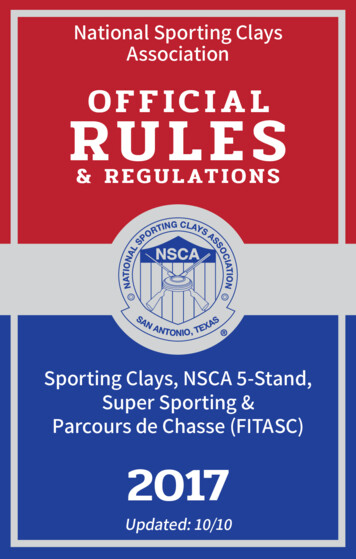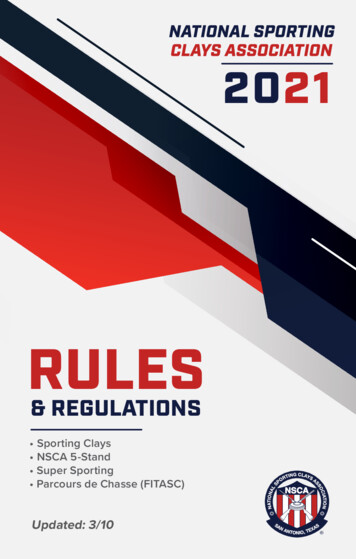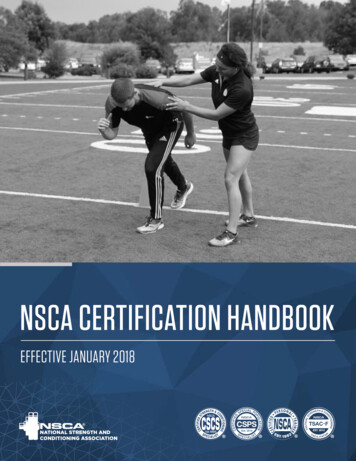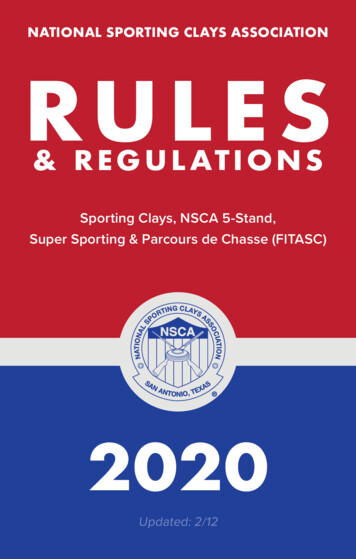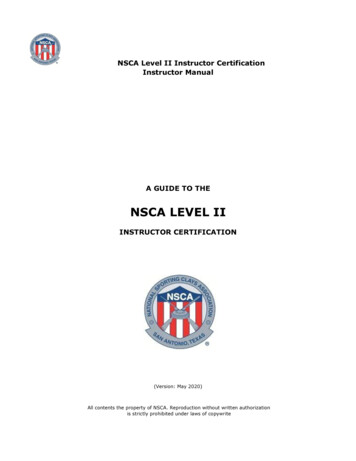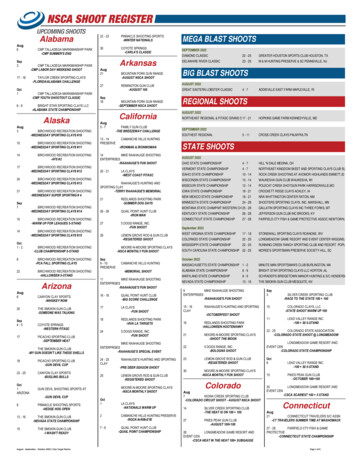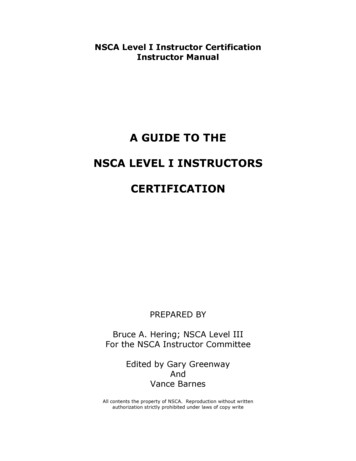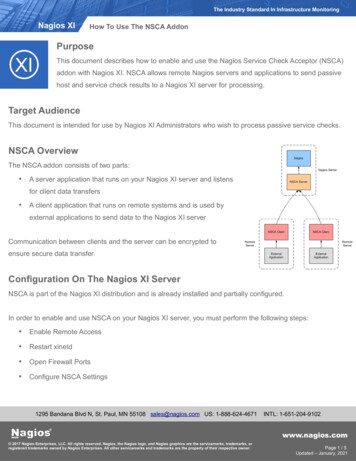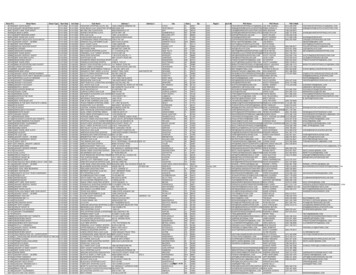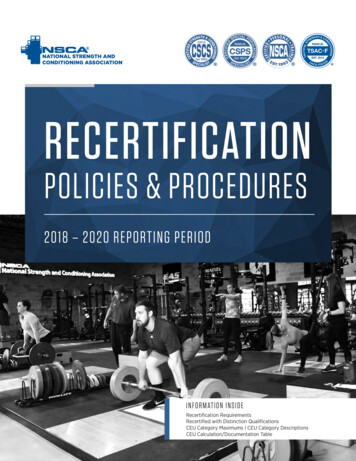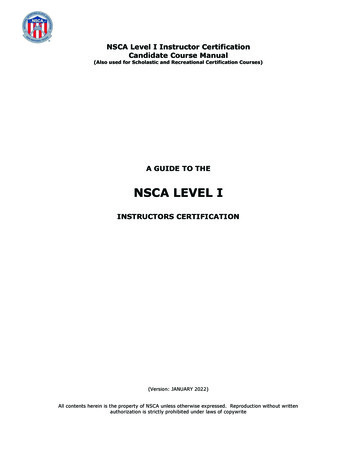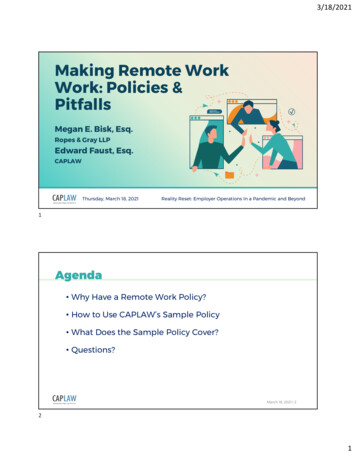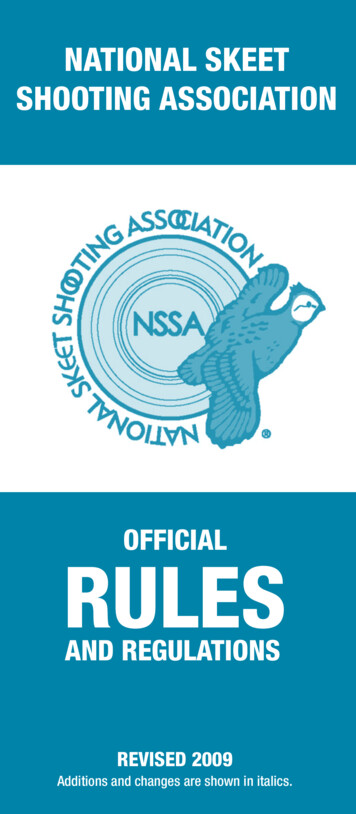
Transcription
NATIONAL SKEETSHOOTING ASSOCIATIONOFFICIALRULESAND REGULATIONSREVISED 2009Additions and changes are shown in italics.
DATEDESCRIPTIONPAGE21/Nov/08New Rule II-C-3-61821/Nov/08Old Rule # II-C-3.b18changed to # II-C-3.c24/Feb/09Old Rule III-G-10updated3925/Feb/09Old Rule III-F-2-hupdated3818/Aug/09Old Rule III-G-10updated3818/Aug/09Old Rule III-F-2-hupdated3818/Aug/09Old Rule II-C-4-rupdated1918/Aug/09Old Rule II-I-7-aupdated2718/Aug/09Old Rule II-D-4-fupdated214/Nov/09Old Rule II-C-4-dthrough II-C-4-n18&199/Dec/09New Rule II-C-4.a.2189/Dec/099/Dec/09New Rule II-C-4.rNew Rule II-D-4.f19,20&219/Dec/09Old Rule II-I-6updated279/Dec/09New Rule 12/Feb/1012/Feb/10New Rule II-A-7-b-2Old Rule II-A-8-bOld Rule V-B-1-aOld Rule II-F-1New Rule III-G-3Old Rule IV-D-16111249233943
SKEET WELCOMES YOUThe great sport of skeet shooting, designed in 1920 bya group of Andover, Massachusetts upland game hunters toimprove their wing shooting, has rapidly caught the fancy ofpeople in all age groups and both sexes. It is now a major sport,with its own international and state organizations. A dedicatedgroup is guiding it carefully to even greater popularity andprestige.Skeet has developed into much more than just an aid tobetter wing shooting or a substitute for hunting. It is now acompetitive sport equaled by few in universal appeal. Matchesare conducted for all gun gauges, and under skeet’s universalclassification system all shooters compete against others oflike ability. Note classification rules, Section V. Competition isheld for four gauges of shotguns, 12, 20, 28 and .410, thoughmany people never use more than one.Guns must be capable of firing two shots since four setsof doubles are included in the regulation 25-shot round. Inaddition, competitive Doubles Events are offered at manytournaments. The gun may be a double barrel (side-by-side orover-and-under), a pump gun or an automatic, depending on theshooter’s preference. Major manufacturers offer specially madeskeet guns, and you should consult them or a good gunsmithbefore buying a shotgun for skeet. Details such as weight,choke, drop and pitch and fit of the gun vary with shooters. Itis actually better to try out several guns, all types if possible,before buying.The National Skeet Shooting Association (NSSA) is anonprofit organization owned and operated by and for itsmembers, sportsmen and women who are dedicated to thedevelopment among its members of those qualities of patriotism and good sportsmanship which are the basic ingredientsof good citizenship, and in general to promote and advancethe interests, welfare and development of skeet shooting andrelated sports.In addition to the present regulation skeet most commonlyshot, the NSSA has an international division for those who wishto shoot under the rules used in international competition withlow gun position and variable timing.We believe that in skeet you will find the finest fellowshipof sportsmen and women in the world. This is a rewarding recreational adventure where the best of sportsmanship prevails.You are welcome to this unique fraternity.Gratuities in skeet are not permitted.National Skeet Shooting Association5931 Roft Road, San Antonio, TX 7-5338 210-688-3371 210-688-3014 fax
National Skeet Shooting AssociationOfficial Rules & RegulationsSECTION I - EQUIPMENT. 6A. TARGETS.6B. AMMUNITION.6C. FIELD LAYOUT.7D. MANDATORY POSITIONS FOR REFEREES.8E. RECOMMENDED POSITIONS FOR SHOOTERS.8F. RECOMMENDED PROCEDURE FOR SETTING DISTANCE ON TARGETS.8G. use of a radar gun.9SECTION II - REGISTERED SHOOTS. 9A. GENERAL.91. Identification of Eligible Shooters.92. Open Shoot Registration.93. Night Shooting.94. Shooting Order.95. Squadding Restrictions .106. Checks – Payments, Over-Payment.107. Club Qualifications and Responsibilities.108. Individual Qualifications and Responsibilities.12B. STANDARD EVENT SPECIFICATION.131. Gauge Specifications.132. Awards Eligibility.133. Concurrent Events.134. Concurrent Event Awards.145. HOA/HAA Titles.146. Minimum Number of Targets.147. High Gun System.148. Method of Breaking Ties.149. NSSA Procedures for Shoot-offs.15C. ELIGIBILITY OF INDIVIDUALS.171. Membership.172. Amateurs.173. Residency Requirements.174. Concurrent Events.18D. TEAM ELIGIBILITY.191. Team Representation.192. State Teams.193. Club Teams.204. Exceptions to Domicile and Club Membership Requirements . .205. Open Teams (Definition).206. Five-Man Teams.207. Two-Man Teams.218. Armed Forces Team Representation.219. NSSA World Championship Five-Man Teams.21E. PROTESTS.21F. DISQUALIFICATION AND EXPULSION.23G. OFFICIAL SCORES.23H. REGISTERED SHOOT REPORTS.251. Reporting Requirements.252. Penalties.253. Financial Report.254. Registered Target Official Report.26I. RECOGNITION AND AWARDS.261. High Average Leaders.262. All-American Team.273. Long Run Records.274. High Overall Averages.275. World Records.276. Determination of Age Groups.277. Rookie.278. Honor Squad.28SECTION III - SHOOTING PROCEDURE. 28A. DEFINITIONS.281. Shooting Positions.282. Gun Position.283. No Bird.284. Regular Target.295. Irregular Target.296. Regular Double.297. Irregular Double.298. Proof Double.299. Shooting Bounds.2910. Balk.2911. Malfunction of Gun.29
12. Defective Ammunition.2913. Dead Target.3014. Lost Target.3015. Optional Shot.3016. Skeet Squad.3017. Round of Skeet.3018. Shooting Up.31B. GENERAL.311. Squad Shooting Procedure For A Round Of Skeet.312. Rules and Procedures for Doubles Events.323. Shooter’s Right To Observe Targets.334. Progress From Station-to-Station.335. Broken Gun.346. Shooting Up.347. Slow Squads.34C. SCORING.34D. GUN MALFUNCTIONS.351. Semi-Automatics.352. Pump Guns.353. Double-Barreled Guns.364. Shell Catching Devices.365. Repeated Targets.366. Number Allowed.367. Loading Two Shells.368. Malfunction on Singles or First Shot Doubles.369. Malfunction Between Shots on Doubles.3710. Fan-Fire.37E. DOUBLES OR PROOF DOUBLES.37F. INTERFERENCE.38G. SAFETY PRECAUTIONS.39SECTION IV - REFEREES. 40A. LICENSED REFEREE.40B. ASSOCIATE REFEREE.41C. CHIEF REFEREE.41D. FIELD REFEREE.42SECTION V - NSSA CLASSIFICATION. 44A. DEFINITIONS.441. NSSA Shooting Year.442. Current Year.443. Previous Year.444. Gauge.445. Class Assigned.446. New Shooter.447. Classified Shooter.448. Running (current) Average.449. Event.4410. Classification of a New Shooter.4511. Re-Classification of a Classified Shooter.4612. Classification of Shooters from Other Clay Target Organizations.4713. Classification Cards.4814. A New Shooter at their Initial Shoot.48B. PROCEDURES.481. Maintaining Shoot Record Card.482. Classification Review.50C. UNIVERSAL CLASSIFICATION TABLES.501. Use of the Universal Classification Tables.502. Individual Classification.503. Compulsory Classes.514. High Overall.51D. TEAM AND OTHER CONCURRENT EVENT CLASSIFICATIONS.52E. RECLASSIFICATION LIMITATIONS.52F. ALTERNATE AWARD SYSTEM.52SECTION VI - INTERNATIONAL SHOOTING. 52A. ELIGIBLE SHOOTERS.53B. CLASSIFICATION PROCEDURES.53C. CLASSIFICATION TABLE FOR INTERNATIONAL EVENTS.53D. RECORDING SCORES.53E. REPORTING SCORES.53F. RECOGNITION AND AWARDS.53g. modified international.53section vii - rules of conduct. 53section VIII - event 6. 57section ix - guidelines for PROTESTS. 58Index to rules. 60
SECTION I - EQUIPMENTA. TARGETSStandard targets of good quality measuring no more thanfour and five-sixteenth (4-5/16) inches in diameter nor morethan one and one-eighth (1-1/8) inches in height shall beused.B. AMMUNITION1. Gauge Specifications - Lead Shota. Shells commercially manufactured by reputable companies, which are clearly labeled and guaranteed as tolead shot sizes and weight are recommended for usein registered skeet shoots. However, NSSA will acceptresults of shoots and register scores where reloadshave been used. NSSA assumes no responsibility inconnection with the use of reloads.b. Gun Clubs are allowed to use alternate shot (other thanlead) for registered shoots: alternate loads must meetindustry standards for "target load" ammunition.2. Reloadsa. The maximum load permissible is described below.This table makes ample allowance for manufacturing purposes, but the use of a proper shot bar iscautioned (a 12 gauge bar designed for 7-1/2 shotwill weigh approximately 11 grains heavy when No.9 shot is used).Gauge122028.410Ounces Lead1-1/87/83/41/2Grains Standard492.2382.8328.1218.8Grains Maximum507394338229b. No shot smaller than No. 9 (2mm) or larger than7-1/2 shall be used in any load.c. Any shooter may elect to have his/her shells weighedby management before entering an event. The shooter must submit all shells to be used in said event.After one shell is selected, weighed and approvedby these standards, the balance of the shells shallbe stamped, approved and sealed by some suitablemethod and not be opened until on the field where theevent is to be shot in the presence of the field referee.Failure to have the field referee witness the breakingof the sealed boxes or containers on their respectivefields shall necessitate the shooter using factoryammunition or risk having his/her score disqualified.Any shooter using approved and sealed ammunitionshall be immune from further checking.d. Challenge Rule: At shoots where shells have notbeen checked, any contestant may, upon formalchallenge presented to shoot management, have thechief referee, who shall use timely discretion, selecta shell from another contestant and have said shellchecked against the standards listed in rule I-B-2-a.To prevent abuse of a shooter with this rule, shootmanagement shall make known the challenger andthe individual challenged. Entire groups or squadsshall not be challenged for purposes of anonymity.
I-B-33. Checking Factory LoadsAny shooter found to be using commercial loads heavierthan the maximum grains permissible as listed in I-B-2-ashall have his/her score disqualified for that event.C. FIELD LAYOUTIt is recommended and desirable for all NSSA registeredtargets to be shot on fields constructed according to thefollowing specifications and the diagram shown on thecenterfold of this book. Field layout deviation will not affectNSSA’s consideration of scores. Under no circumstanceswill protests based on alleged irregularity of field layoutbe considered.1. A skeet field shall consist of eight (8) shooting stationsarranged on a segment of a circle of twenty-one (21)yards radius, with a base cord exactly one hundredtwenty (120) feet, nine (9) inches long, drawn six (6) yardsfrom the center of the circle. The center of the circle isknown as the target-crossing point and is marked bya stake. Station 1 is located at the left end of the basewhile standing on the periphery of the segment. Stations 2 to 6, inclusive, are located on the periphery atpoints equidistant from each other. The exact distancebetween Stations 1 and 2, 2 and 3, etc., is twenty-six(26) feet, eight and three-eighths (8-3/8) inches. Station8 is located at the center of the base chord.a. Shooting Stations 1 and 7, each a square area three(3) feet on a side, shall have two sides parallel to thebase chord.b. Shooting Stations 2 to 6, inclusive, each a squarearea, three (3) feet on a side, shall have two sidesparallel to a radius of the circle drawn through thestation marker.c. Shooting Station 8 is a rectangular area three (3) feetwide by six (6) feet long, with the long sides parallelto the base chord.2. The location of each shooting station shall be accuratelydesignated.a. The marker for shooting Stations 1-7, inclusive, ison the center of the side nearest the target crossingpoint.b. The marker for shooting Station 8 is on the centerpoint of the base chord.3. One target should emerge from a skeet house (calledhigh house) at a point three (3) feet in back of StationMarker 1 (measured along the base chord extended), andten (10) feet above the ground level. The other shouldemerge from a skeet house (called low house) at a pointthree (3) feet in back of Station Marker 7 (measure alongthe base chord extended), and two and one-half (2-1/2)feet from the base chord extended (measure on side oftarget-crossing point), and three and one-half (3-1/2)feet above the ground.4. Mandatory markers (where geographically possible)shall be placed at points 44 yards and 60 yards fromboth the high house and the low house to indicate theshooting boundary limit of 44 yards. These distancesshall be measured along a line and the flight of a regulartarget 60 yards from the opening (where target emerges)
in skeet house through the target-crossing point. The60-yard distance markers must be suitably marked toindicate Station 8 ground level where geographicallypossible.5. The target-crossing point must be marked in a visiblemanner where geographically possible.6. It is recommended to remove posts or box stands tangentto the front of the stations interfering with the shooter.7. It is recommended and desirable that the side of theskeet house, from the bottom of the chute to the top ofthe house, be very light color or painted white wherefeasible.8. It is recommended if more than one field is in line thata fence be constructed between fields.9. Unusual or undesirable field variations must be correctedbefore contract negotiations are completed.10. The pull cord will be a minimum length to allow thereferee to reach all mandatory referee positions andwill have high house, low house and doubles releasebuttons.D. MANDATORY POSITIONS FOR REFEREES1. For shooting Station 1 (1R), stand six feet to the right andthree (3) feet back of the front of Station 1 where possible.2. For shooting Station 2 (2R), stand six (6) feet back and three(3) feet to the right of Station 2.3. For shooting Stations 3, 4, 5 and 6 (3-4-5-6R), stand six(6) feet back and three (3) feet to the left of the respectivestation.4. For shooting Station 7 (7R), stand six (6) feet to the leftand three (3) feet back of the front of Station 7 where possible.5. For shooting Station 8 (8R), stand on center line of the field,not less than six (6) feet from shooter (and not more than10 feet).6. During doubles shooting, as shooters are coming backaround the circle, referees should stand six feet backand three feet to the right of Stations 5, 4 and 3. (Seediagram on pages 30-31)Exception: A shooter may request the referee to movebehind the station at Station 3 or 5.E. RECOMMENDED POSITIONS FOR SHOOTERSIt is recommended for courtesy to team members thatshooters do not advance more than one-third of the wayto the next shooting station until all shooters on the squadhave completed the station. Furthermore, shooters shouldstand a minimum of six feet behind the shooter while waiting to shoot.F. RECOMMENDED PROCEDURE FOR SETTING DISTANCE ONTARGETSIt is recommended to adjust the skeet machine spring to atension that will just reach the 60 yard stake, passing neardead center on the target setting hoop, under a “no wind”condition. This distance setting has a plus/or minus two (2)yard allowance, but should be as close to 60 yards as possible. Once this setting is made, it is unnecessary to changethe spring tension during a tournament unless the spring
I-Fbecomes defective. The prevailing wind during a shoot maycause the targets to fall far short or long, but they are legaltargets providing they pass through the setting hoop.G. use of a radar gunThe use of a radar gun by shoot management for settingtargets is permitted so long as the height and distancerequirements specified under Rule III-A-4, Definition of aRegular Target, are complied with. Recommendations forthe use of a radar gun are available from NSSA MemberServices, posted on the NSSA website and are in the GunClub Manual.SECTION II - REGISTERED SHOOTSA. GENERAL1. Identification of Eligible ShootersMembers shall receive a new classification card as soonas possible after October 31.a. This card will be of high quality paper and is to be usedthroughout the shooting year. Classification cards willbe a different color each year for ease of identification. Replacement cards can be obtained from NSSAHeadquarters if lost or accidentally destroyed.b. Presentation of a classification card, indicating amember’s shooting record and paid membershipstatus, and a NSSA membership card is required forentry in a registered shoot.c. Classification for the beginning of the year shall beindicated in the appropriate place on each classification shoot record card.d. These cards also shall contain columns in which theholders are to keep their up-to-date averages postedfor each gun.2. Open Shoot RegistrationIf a state or zone shoot is "Open" then gun titles andawards, both monetary and non-monetary, go to eventwinners, and the state title and awards are restrictedto bona fide state residents. Two shoot reports must besubmitted.3. Night ShootingRegistered shooting at night is permissible. All scoresrecorded for night registered shoots will receive the sametreatment as any other registered shoot. Participants innight registered shoots must accept the conditions atthe club where the shoot is held and no protest concerning shooting conditions; e.g., light conditions, natural orartificial, etcetera, will be allowed. At night registeredshoots, all orange targets will be used unless otherwisepublished in the program.4. Shooting OrderThe management shall determine the shooting order of theindividuals in each squad at the beginning of the round,and the shooters shall adhere to this order. If the order ischanged during any succeeding round of the same event,each squad member shall be responsible that his/hername be in the proper order on the respective score sheet,and that the change be plainly indicated for the attentionof the final recorder. Each squad shall report to the fieldat its appointed time. Upon failure of a shooter to appearat the appointed time, where a regular schedule has been
posted in advance, or after proper call, the squad shallproceed without the absent shooter and the offender bedropped to the first vacancy in the schedule, or if thereis no vacancy, to the bottom of the list. Weather conditions shall not be deemed sufficient excuse for delay intaking the field or proceeding with the round, unless allshooting has been officially suspended at the discretionof management.5. Squadding RestrictionsThe squadding of practice shooting in a registered eventshall not be allowed. It is permissible to squad Event 6registered with regular registered events. Violations ofthis rule shall be sufficient cause for non-registration ofall scores in the squad. Exception: If there should bea single entry in the last squad of any event, shootmanagement may allow no more than two additionalshooters to shoot for practice, but only if requestedto do so by the lone entry on said last squad. Pacerfor lone participant on a field in shoot-off shall not bepermitted.6. Checks - Payments, Over-PaymentAnyone who presents a check at any shoot that isreturned for insufficient funds or other causes, maynot compete in any registered shoot until full paymenthas been made to the individual or club to which it waspresented. Any club receiving such a check shall reportname and address of the shooter issuing the checkto the NSSA and to its own state, territorial or districtassociation. Upon notification by NSSA, the shooterhas 15 days to make the check good, or he/she will besuspended for six months. A second o
3 SKEET WELCOMES YOU The great sport of skeet shooting, designed in 1920 by a group of Andover, Massachusetts upland game hunters to improve their wing shooting, has rapidly caught the fancy of
